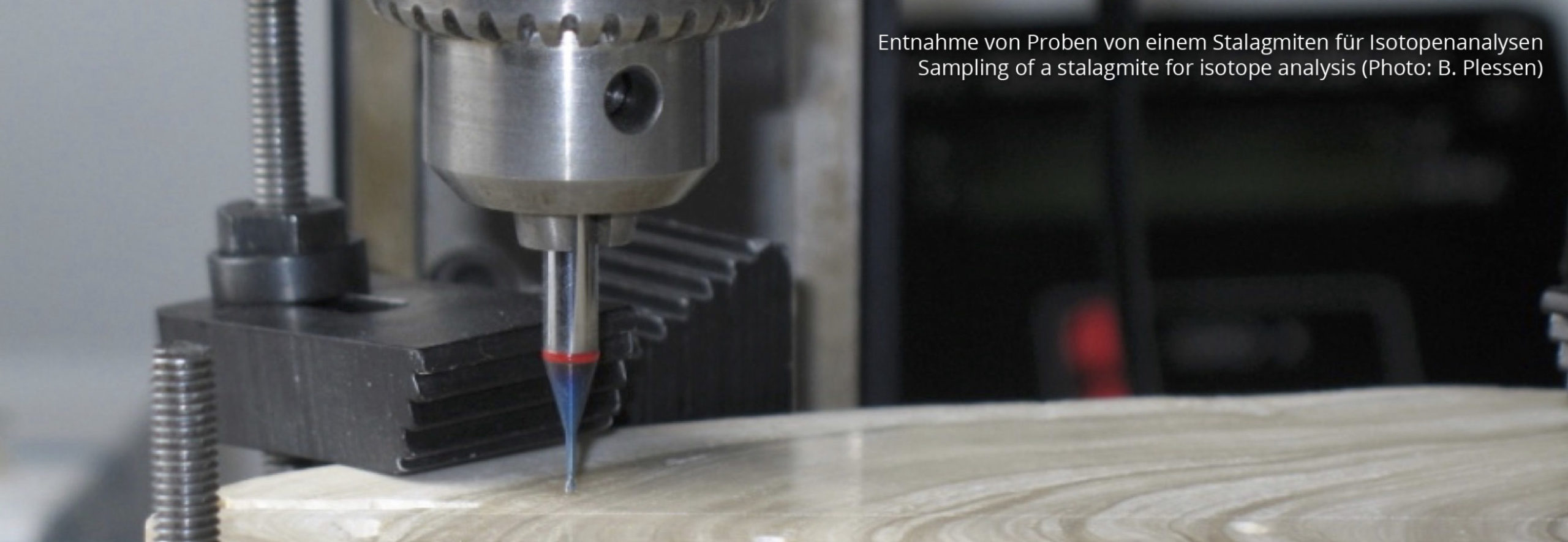Results
- Abrupt Climate ChangeAmong other things, new methods are being developed at PIK that, on the one hand, investigate new aspects in palaeoclimate data, but also cope with the difficulties usually associated with palaeoclimate analyses – such as gaps in the data, age uncertainties, or irregularities in the data sampling. While this is basic research, it is also immediately… Read more: Abrupt Climate Change
- Biomineralisation of calcite by bacterial isolatesUsing stalactite material and fluvialfluvial Durch fließendes Wasser verursacht; zum Beispiel: “Fluviale Sedimente” = durch fließendes Wasser abgelagertes Material. sediments from the Blessberg cave, the diversity and activity of the occuring bacteria and their formation of carbonate minerals were investigated. For this purpose, various techniques such as phylogenetic analyses, bacterial cultivation, electron microscopy, X-ray spectroscopy, confocal… Read more: Biomineralisation of calcite by bacterial isolates
- Climate Zone Shift in central EuropeThe three stalagmites BB-1 to BB-3 were geochemically investigated by GFZ Potsdam, Ruhr-Uni Bochum, PIK Potsdam, Uni Mainz and Northumbria University. The dating was done at the University of Mainz. Stalagmite BB-1 grew 5,600 to 600 years ago, BB-2 6,200 to 3,700 years ago, and BB-3 (although the shortest) 11,200 to 5,300 years ago. At GFZ,… Read more: Climate Zone Shift in central Europe
- First Reconstruction of the Holocene ClimateThe first results of the geochemical analyses of the three stalagmites BB-1 to BB-3 already allow conclusions about the climatic changes of the last 14,000 years. A detailed interpretation can be found in the article Climate zone shift in Central Europe.
- Modelling of karstificationThe strength and speed of karstification depends on various parameters, such as water balance or the existing rocks. A karstification model was used to model how karstification had developed in the area of the Schalkauer Platte and how it will develop in the future. The model shows regional differences in the karstification potential. Especially in the… Read more: Modelling of karstification
- Novel methods for studying palaeoclimate dynamicsAt PIK, among other things, new methods are being developed that, on the one hand, can be used to investigate new aspects in palaeoclimate data, but on the other hand can also cope with the difficulties usually associated with palaeoclimate analyses – such as gaps in data series, uncertainties in the dating, or irregularities in the… Read more: Novel methods for studying palaeoclimate dynamics
- Stalagmite growth during MIS 3Paleoclimate investigations of the sinter samples BB-9, BB-10, and BB-15 show nine growth phases that coincide with Dansgaard-Oeschger events.
- Stalagmite growth during MIS 9 and MIS 11The stalagmite BB2-1 from the Bleßberg Cave 2 was systematically dated. Its growth took place during isotopeIsotop Chemische Elemente können aus verschieden aufgebauten Atomen gebildet sein. Die Anzahl Protonen im Atomkern ist zwar dabei gleich, aber die Anzahl der Neutronen kann variieren. Man spricht dann von Isotopen, deren Massen kleine, aber messbare Unterschiede aufweisen. Der Atomkern des Sauerstoffs besteht z. B. aus 8 Protonen und in der Regel aus 8 Neutronen. Es gibt aber auch Sauerstoff, dessen Kerne aus 8 Protonen und 9 oder 10 Neutronen bestehen (neben selteneren, instabilen Sauerstoffisotopen). Um das zu kennzeichnen, gibt man zusätzlich zum chemischen Symbol noch die Massenzahl (Summe aus Protonen und Neutronen) an, also 16O, 17O oder 18O. Die unterschiedlichen Isotope verhalten sich zwar chemisch identisch, physikalisch aber - aufgrund ihres unterschiedlichen Gewichtes - leicht unterschiedlich. Damit stellen sie äusserst wertvolle Marker dar, die uns wichtige Hinweise zur Änderung des Klimas, der Umgebungsvegetation, Bodenaktivität und vielem mehr geben. stages 11 and 9, i.e. between 450 and 400 ka BPka BP Mit "ka BP" sind "Tausend Jahre vor 1950" gemeint. Das "BP" steht für "before present", was in der Paläoklima-Wissenschaft als 1950 festgelegt wurde. "11.000 ka BP" bedeuted also 11 Tausend Jahre vor 1950, oder unter Verwendung unseres gewohnten Kalenders: 9050 v. Chr. and between 350 and 320 ka BP.
- Thermoluminiscence Dating of speleothemesAt LIAG, the stalagmite BB2-1 was used to investigate how thermoluminescence dating can be adjusted to provide accurate ages. The age results were compared with U/ThU/Th-Datierung Die U/Th-Datierung ist eine sehr präzise radiometrische Altersbestimmung auf Basis der Uran-Thorium-Zerfallsreihe. Das Uran zerfällt mit bekannten Halbwertszeiten (245.500 Jahre) zum Tochterelement Thorium. Stalagmiten bauen bei ihrem Wachstum (fast) nur das wasserlösliche Uran ein, während das schlecht bewegliche Thorium zum größten Teil im Boden und Epikarst über der Höhle verbleibt. Das kann man nutzen, um die Zeit zu berechnen, die seit der Ausfällung der untersuchten Karbonatprobe vergangen ist. Moderne massenspektrometrische Verfahren erlauben Altersbestimmungen mit der U/Th-Methode bis zu 700.000 Jahren vor Heute. ages measured at the University of Mainz, and they are in good agreement within the margin of error.
